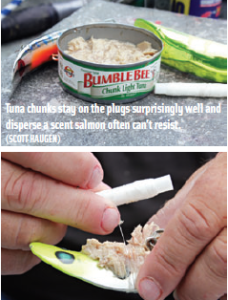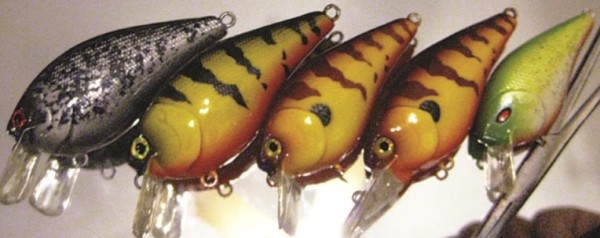PLUGGING AWAY AT CHINOOK
TUNA-WRAPPED PLUGS
ONE WAY TO STALK SALMON
By Scott Haugen
Four decades has passed since I landed my first Chinook salmon on a plug, a U20 Flat- Fish to be exact. Since that time there have been numerous Chinook, coho and steelhead taken by back trolling plugs, a technique I never tire of using. Over the years I’ve wrapped plugs with various baits, from herring to bacon, scent-soaked sponges to squid. Then, about a decade ago, a buddy introduced me to a bait option that could be wrapped on a plug, one I’d never before tried. It was tuna, and though I’d fished it from a spawn sack hanging on the trailing hook of big plugs, I’d never considered wrapping it.
Start with a can of tuna, either oil packed or water-packed. Between the thumb and three fingers, take a pinch of tuna and position it on the belly of the plug. Mag Lips, Hawg Nose Flat Fish and Kwikfish can all effectively be wrapped in this way.
The first time I tried fishing a tuna-wrapped plug I thought there was no way the tuna chunks would stay on when wrapped with simple thread. But as the tuna compresses on to the belly-side of the plug, it firms up. True, little bits of tuna will fall off due to the water current and plug action, but that’s what creates a stronger scent trail for fish to follow. Once the tuna is balanced on the plug, start wrapping it with stretthread. This elastic thread binds the tuna chunks, keeping them secure and intact, surprisingly well. If you can’t find stretchy thread at the local sporting goods store, regular plug-wrapping thread will work fine, but use more wraps than normal. Even in rough water and when bounced along the bottom, the stretchy thread holds the tuna in place.
Once you’ve wrapped the tuna securely in place from the tail-end up to the eye of the belly hook, flip the belly hook over onto the already secured tuna and continue wrapping past the eye of the belly hook, toward the bill of the plug. How far up you go depends on the plug being used and how its action is influenced by the addition of the tuna. Once the tuna is securely wrapped, it’s ready to fish. Even after fish hit them, usually enough tuna is intact to keep the plug fishing.
As with any plug, the approaches are the same when fishing those wrapped with tuna. Depending on what river you’re fishing,what the conditions are like and what plugs you’re working, you’ll have to figure out for yourself what works best in your situation.
Some plugs simply pull more efficiently when flat lined, while others
track just as good with a surprising amount of tuna strapped to them. Experiment with different combinations in a variety of water settings and soon you’ll soon be dialed-in.
In deeper holes a diver may be necessary to help get that wrapped plug down. But if using a Hawg Nose Flat-
Fish, flat lining to 20 feet deep is possible under ideal conditions.
There are two schools of thought when running a diver with a tuna wrap setup. One is to go with a diver that relieves some of the stress on the plug, whereby keeping more of the tuna intact for a longer period. The other theory is to forego the diver, allowing the plug to move more aggressively, whereby possibly establishing a heavier scent trail. There is no right or wrong approach, as much of what we know, or think we know, in the salmon fishing world is based on speculation. On a recent spring Chinook trip, a buddy and I moved through a deep hole with jumbo divers keeping our tuna-wrapped plugs close to the bottom. Our goal was to stay deep as it was late morning, the sun was on the water and several boats had already
passed through the hole. We had one strike on our first pass, nothing on our second. Then we removed the divers and ran back through the same water. I missed a good strike but my buddy connected. On the next pass I tagged another fish.
The only difference in those final passes was that we used no diver, just tuna-wrapped plugs.Whether the fish were suspended a bit or liked the action of the plug better without a diver we’ll never know, but the fact remains they were responsive to the change. For a decade now, I’ve been fishing tuna-wrapped plugs, and one thing
I’ve found is they seem to produce bites when other offerings can’t. I don’t know if this is because the fish simply respond to a different scent being in the water or that they just got agitated
into biting. Some of the most impressive success
stories I’ve witnessed with tuna wrapped plugs is how well they produce when fished behind other anglers. Be it amid heavy boat traffic or intense bank pressure, the tuna simply ignites a spark that eggs, herring and other baits don’t always produce.
This season try wrapping some plugs with tuna. Based on my experience, whatever river you try them in, I’m confident you’ll be impressed.




